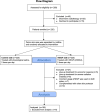The effect of recombinant human epidermal growth factor on radiation dermatitis in rectal and anal cancer patients: a self-controlled study
- PMID: 36335306
- PMCID: PMC9637292
- DOI: 10.1186/s12885-022-10226-x
The effect of recombinant human epidermal growth factor on radiation dermatitis in rectal and anal cancer patients: a self-controlled study
Abstract
Background: Our previous study reported that recombinant human epidermal growth factor (rhEGF)-triggered EGFR internalization promoted radioresistance. Here, we aimed to evaluate the effect of rhEGF on the skin protection of rectal and anal cancer patients receiving radiotherapy.
Methods: One hundred and ninety-three rectal and anal cancer patients who received radiotherapy were prospectively enrolled from January 2019 to December 2020. To perform self-controlled study, the left and right pelvic skin area (separated by midline) were randomly assigned to the rhEGF and control side. The association between radiation dermatitis and factors including rhEGF, the dose of radiotherapy and tumor distance from anal edge were analyzed.
Results: Among 193 enrolled patients, 41 patients (21.2%) did not develop radiation dermatitis, and 152 patients (78.8%) suffered radiation dermatitis on at least one side of pelvic skin at the end of radiotherapy. For the effect on radiation dermatitis grade, rhEGF had improved effect on 6 (4.0%) patients, detrimental effect on 2 (1.3%) patients, and no effect on 144 (94.7%) patients. Whereas for the effect on radiation dermatitis area, rhEGF showed improved effect on the radiation dermatitis area of 46 (30.2%) patients, detrimental effect on 15 (9.9%) patients, and no effect on 91 (59.9%) patients. The radiation dermatitis area of rhEGF side was significantly smaller than that of control side (P = 0.0007).
Conclusions: rhEGF is a skin protective reagent for rectal and anal cancer patients receiving radiotherapy.
Trial registration: Chinese Clinical Trial Registry identifier: ChiCTR1900020842; Date of registration: 20/01/2019.
Keywords: Clinical trial; Radiation dermatitis; Rectal and anal cancer; rhEGF.
© 2022. The Author(s).
Conflict of interest statement
The authors declare that they have no competing interests.
Figures



Similar articles
-
Topical use of recombinant human epidermal growth factor (EGF)-based cream to prevent radiation dermatitis in breast cancer patients: a single-blind randomized preliminary study.Asian Pac J Cancer Prev. 2013;14(8):4859-64. doi: 10.7314/apjcp.2013.14.8.4859. Asian Pac J Cancer Prev. 2013. PMID: 24083759 Clinical Trial.
-
Therapeutic effects of recombinant human epidermal growth factor (rhEGF) in a murine model of concurrent chemo- and radiotherapy-induced oral mucositis.J Radiat Res. 2010;51(5):595-601. doi: 10.1269/jrr.10069. J Radiat Res. 2010. PMID: 20921827
-
Foam dressing with epidermal growth factor for severe radiation dermatitis in head and neck cancer patients.Int Wound J. 2016 Jun;13(3):390-3. doi: 10.1111/iwj.12317. Epub 2014 Jun 20. Int Wound J. 2016. PMID: 24947011 Free PMC article.
-
The use of epidermal growth factor in dermatological practice.Int Wound J. 2023 Aug;20(6):2414-2423. doi: 10.1111/iwj.14075. Epub 2022 Dec 30. Int Wound J. 2023. PMID: 36584669 Free PMC article. Review.
-
Consensus guidelines for the management of radiation dermatitis and coexisting acne-like rash in patients receiving radiotherapy plus EGFR inhibitors for the treatment of squamous cell carcinoma of the head and neck.Ann Oncol. 2008 Jan;19(1):142-9. doi: 10.1093/annonc/mdm400. Epub 2007 Sep 4. Ann Oncol. 2008. PMID: 17785763
Cited by
-
Management of Radiation-induced Tissue Injuries: A Review of Current Treatment Strategies.Plast Reconstr Surg Glob Open. 2023 Jun 16;11(6):e5043. doi: 10.1097/GOX.0000000000005043. eCollection 2023 Jun. Plast Reconstr Surg Glob Open. 2023. PMID: 37456134 Free PMC article.
-
The effect of various interventions on the prevention of radiation dermatitis: a network meta-analysis.Am J Transl Res. 2024 May 15;16(5):1859-1879. doi: 10.62347/XLGT5405. eCollection 2024. Am J Transl Res. 2024. PMID: 38883361 Free PMC article. Review.
-
Chinese clinical practice guidelines for the prevention and treatment of radiation-induced dermatitis.Precis Radiat Oncol. 2023 Sep 10;7(3):160-172. doi: 10.1002/pro6.1208. eCollection 2023 Sep. Precis Radiat Oncol. 2023. PMID: 40337200 Free PMC article.
-
Global hotspots and research trends of radiation-induced skin injury: a bibliometric analysis from 2004 to 2023.Front Oncol. 2024 Aug 26;14:1430802. doi: 10.3389/fonc.2024.1430802. eCollection 2024. Front Oncol. 2024. PMID: 39252945 Free PMC article.
-
Reconsidering the Role of V-Y Fasciocutaneous Flaps in Abdominoperineal Resection Reconstruction With the Addition of a Pelvic Exclusion Mesh.Plast Reconstr Surg Glob Open. 2025 May 2;13(5):e6769. doi: 10.1097/GOX.0000000000006769. eCollection 2025 May. Plast Reconstr Surg Glob Open. 2025. PMID: 40321332 Free PMC article.
References
-
- Caravatta L, Mantello G, Valvo F, Franco P, Gasparini L, Rosa C, Slim N, Manfrida S, De Felice F, Gerardi MA et al. Radiotherapy with Intensity-Modulated (IMRT) Techniques in the Treatment of Anal Carcinoma (RAINSTORM): A Multicenter Study on Behalf of AIRO (Italian Association of Radiotherapy and Clinical Oncology) Gastrointestinal Study Group. Cancers (Basel). 2021;13(8):1902. - PMC - PubMed
MeSH terms
Substances
Grants and funding
LinkOut - more resources
Full Text Sources
Medical
Research Materials
Miscellaneous

